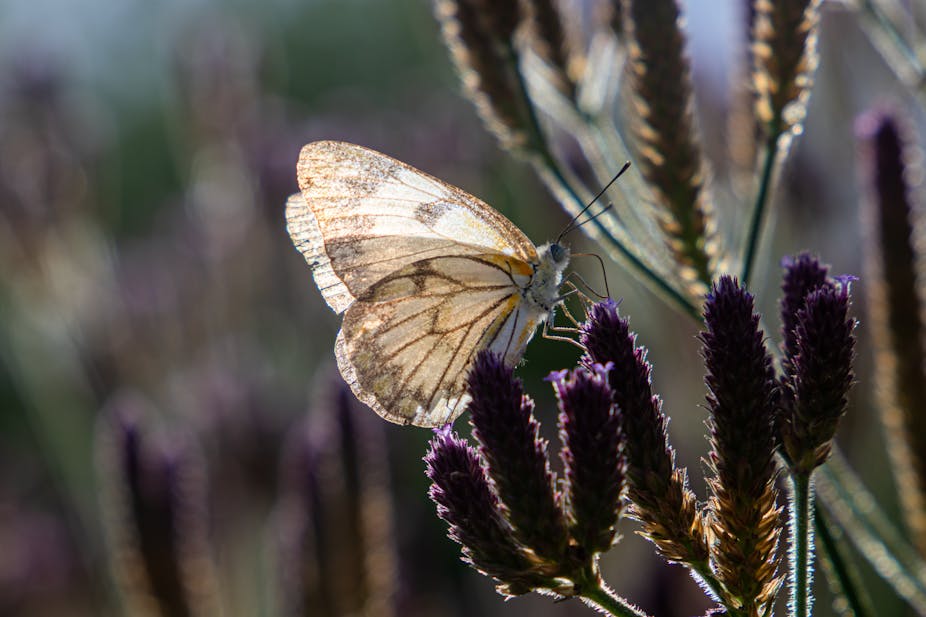Each year around mid-summer, somewhere between December and mid-January, the skies of South Africa’s Gauteng province, including the city of Johannesburg, fill with small white butterflies. Some land in people’s gardens, allowing a closer look at the thin brown markings on their wings. Those markings give the butterflies their name: the brown-veined white butterfly (Benenois aurota).
Their annual migration takes between 80,000 and 155,000 butterflies per hour from South Africa’s Kalahari region to Mozambique, a journey of hundreds of kilometres via Gauteng. They are leaving the arid Kalahari in search of food and moisture.
The butterflies move in a huge group and their migration is relatively quick – it takes a week or so for most of them to move through Gauteng. The resulting clouds of butterflies are a beautiful spectacle, noticed not just by butterfly enthusiasts and scientists, but by residents.
This year, the butterflies have arrived early.
That may seem unimportant. But, to phenologists like myself, it’s evidence of changes in the environment that require close attention. Phenology refers to the timing of annually recurrent biological events: the blossoming of jacaranda trees, for instance, or a mass butterfly migration.
Read more: Jacarandas in parts of South Africa are flowering earlier: why it’s a warning sign
Across the world, phenological events are occurring increasingly earlier as a result of climate change. The temperatures that used to signal the onset of spring for plants and animals are now occurring earlier in most parts of the world. Simultaneously, the timing and amount of precipitation are changing too.
Climate change is intangible to many people. We know it is happening, but our larger surroundings look the same – for now. It’s difficult to feel the 1.1°C post-industrial global temperature increase. But we do notice when the jacarandas flower earlier or butterflies arrive in our gardens earlier. This is important in raising public awareness regarding climate change.
Media records
In an article published earlier this year, my students and I used media reports to quantify how the timing of the annual butterfly migration had changed over nearly 100 years.
The butterfly migration has featured in newspaper reports for many years. More recently, with the advent of social media, these butterflies have also been photographed and posted on Instagram, tweeted, and posted on a range of other social media platforms.
These print and social media records are a gold mine for phenologists. For our research we recorded the date of newspaper articles and social media posts relating to sightings of these butterflies in Johannesburg and used this to quantify changes in the timing.
We also analysed local records of rainfall and daily maximum, minimum and average temperatures measured by the South African Weather Service. Although our butterfly arrival date database extended much further back than many of these climate records, we were able to compare the datasets over the period of overlap to determine the role of climate in driving the changes in timing.
We managed to compile a total of 120 records of the brown-veined white butterflies in Johannesburg. From these, we found that the arrival dates have advanced by 2.9 days per decade over the past century, from approximately mid-January to mid-December. Their November arrival this year is earlier than any of the dates in our record. However, because we must rely on print and social media reporting, it is very possible that it is not the earliest that they have ever arrived.
The reason for the advance in timing relates to complex relationships with climate. The strongest statistical relationship that we found in this study was between the arrival dates and the combination of minimum temperature and precipitation during December, which for the majority of the dataset was the month either before or during the migration.
In summers with warmer conditions, and less rainfall, the butterflies arrived earlier. This year, the onset of rainfall in the summer-rainfall zone was much later than usual, and September and October were marked by very hot and dry conditions. Although Gauteng had a wet November, the conditions in the months prior to migration are the most important in determining the timing.
Assessing threats
Soon the butterflies will leave Johannesburg, continuing on their journey towards Mozambique. Not all of the butterflies will make it and, due to a short lifespan (just two weeks), even those who reach their end destination won’t live for much longer.
We don’t know for sure when the next group will come through Gauteng. But phenologists will be watching carefully, using data about timing and temperature to assess threats to the butterflies and the ecosystems they inhabit.

